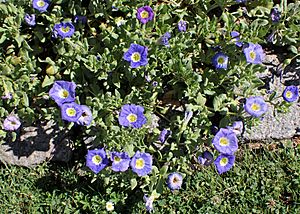Nolana paradoxa facts for kids
Quick facts for kids Nolana paradoxa |
|
|---|---|
 |
|
| At the Berlin Botanical Garden and Botanical Museum | |
 |
|
| Botanical illustration | |
| Scientific classification | |
| Genus: |
Nolana
|
| Species: |
paradoxa
|
| Synonyms | |
|
List
|
|
The Nolana paradoxa, also known as the Chilean bellflower, is a beautiful flowering plant. It belongs to the Solanaceae family, which includes many well-known plants like tomatoes and potatoes. This plant is originally from Chile, a country in South America.
About the Chilean Bellflower
The Chilean bellflower is a plant that spreads out, making it great for covering ground or lining garden edges. It grows to about 9 inches (23 cm) tall. This plant is considered a "half-hardy annual," meaning it usually lives for one growing season and might need some protection from cold weather.
Growing Conditions
For the Chilean bellflower to grow its best, it needs lots of sunshine. It thrives in places where it can get full sun all day. Gardeners sometimes choose a special type of this plant called 'Blue Bird' for its unique qualities.
Why Scientists Study It
Scientists find the Nolana paradoxa very interesting. They use it as a "model system" to study flower color. This means they learn how flowers get their different colors by looking closely at this plant. By studying its genes, they can understand how colors change and develop in flowers.
See also
 In Spanish: Suspiro costero para niños
In Spanish: Suspiro costero para niños

